Effect of Neutron Irradiation on the Electronic and Optical Properties of AlGaAs/InGaAs-Based Quantum Well Structures
Abstract
:1. Introduction
2. Materials and Methods
3. Results
3.1. Electrophysical Properties
3.2. Photoluminescence Spectroscopy
3.3. High Resolution X-ray Diffractometry
4. Conclusions
Author Contributions
Funding
Institutional Review Board Statement
Informed Consent Statement
Data Availability Statement
Conflicts of Interest
References
- Ďuran, I.; Entler, S.; Grover, O.; Bolshakova, I.; Výborný, K.; Kočan, M.; Jirman, T.; Vayakis, G.; Vasyliev, O.; Radishevskyi, M.; et al. Status of Steady-State Magnetic Diagnostic for ITER and Outlook for Possible Materials of Hall Sensors for DEMO. Fusion Eng. Des. 2019, 146, 2397–2400. [Google Scholar] [CrossRef]
- Haned, N. Nano-Tesla Magnetic Field Magnetometry Using an InGaAs–AlGaAs–GaAs 2DEG Hall Sensor. Sens. Actuators A Phys. 2003, 102, 216–222. [Google Scholar] [CrossRef]
- Sadeghi, M.; Sexton, J.; Liang, C.W.; Missous, M. Highly Sensitive Nanotesla Quantum-Well Hall-Effect Integrated Circuit Using GaAs–InGaAs–AlGaAs 2DEG. IEEE Sens. J. 2015, 15, 1817–1824. [Google Scholar] [CrossRef]
- Khan, M.A.; Sun, J.; Li, B.; Przybysz, A.; Kosel, J. Magnetic Sensors-A Review and Recent Technologies. Eng. Res. Express 2021, 3, 022005. [Google Scholar] [CrossRef]
- Bolshakova, I.; Shtabalyuk, A.; Shurygin, F.; Vasilevskii, I.; Viererbl, L.; Duran, I.; Kovalyova, N.; Kovarik, K.; Kost, Y.; Makido, O.; et al. Prospects of Using In-Containing Semiconductor Materials in Magnetic Field Sensors for Thermonuclear Reactor Magnetic Diagnostics. IEEE Trans. Magn. 2013, 49, 50–53. [Google Scholar] [CrossRef]
- Weaver, B.D.; McMorrow, D.; Cohn, L.M. Radiation Effects in III-V Semiconductor Electronics. Int. J. High Speed Electron. Syst. 2003, 13, 293–326. [Google Scholar] [CrossRef]
- Claeys, C.; Simoen, E. GaAs Based Field Effect Transistors for Radiation-Hard Applications. In Radiation Effects in Advanced Semiconductor Materials and Devices; Springer Series in Materials Science; Springer: Berlin/Heidelberg, Germany, 2002; Volume 57, pp. 245–280. ISBN 978-3-642-07778-4. [Google Scholar]
- Ohyama, H.; Vanhellemont, J.; Takami, Y.; Hayama, K.; Kudou, T.; Kohiki, S.; Sunaga, H.; Hakata, T. Degradation of InGaAs Pin Photodiodes by Neutron Irradiation. Semicond. Sci. Technol. 1996, 11, 1461–1463. [Google Scholar] [CrossRef]
- Liu, M.Q.; Zhang, S.Y.; Wang, T.B.; Tan, Z.C.; Du, C.H.; Zeng, C.; Aierken, A. Impacts of 14 MeV Neutron Irradiation on Electrical and Spectral Properties of Flexible GaInP/GaAs/InGaAs Solar Cells. Sol. Energy Mater. Sol. Cells 2023, 255, 112294. [Google Scholar] [CrossRef]
- Shatalov, A.; Subramanian, S.; Dentai, A. Neutron Irradiation Effects in InP/InGaAs Single Heterojunction Bipolar Transistors. IEEE Trans. Nucl. Sci. 2000, 47, 2551–2556. [Google Scholar] [CrossRef]
- Dupont-Nivet, E.; Pasquali, M. Neutron Effects on HEMT Devices. In Proceedings of the RADECS 91 First European Conference on Radiation and its Effects on Devices and Systems, La Grande-Motte, France, 9–12 September 1991; pp. 189–193. [Google Scholar]
- Papaioannou, G.J.; Papastamatiou, M.; Arpatzanis, N.; Dimitrakis, P.; Papastergiou, C. Neutron Radiation Effects in HEMTs. In Proceedings of the RADECS 93, Second European Conference on Radiation and Its Effects on Components and Systems (Cat. No.93TH0616-3), St. Malo, France, 13–16 September 1993; pp. 207–212. [Google Scholar]
- Papastamatiou, M.; Arpatzanis, N.; Papaioannou, G.J.; Papastergiou, C.; Christou, A. Neutron Radiation Effects in High Electron Mobility Transistors [AlGaAs/GaAs]. IEEE Trans. Electron Devices 1997, 44, 364–372. [Google Scholar] [CrossRef]
- Ohyama, H.; Simoen, E.; Kuroda, S.; Claeys, C.; Takami, Y.; Hakata, T.; Kobayashi, K.; Nakabayashi, M.; Sunaga, H. Degradation and Recovery of AlGaAs/GaAs p-HEMT Irradiated by High-Energy Particle. Microelectron. Reliab. 2001, 41, 79–85. [Google Scholar] [CrossRef]
- Paccagnella, A.; Del Papa, C.; Chitussi, P.; Fuochi, P.G.; Benetti, P. Radiation Induced Degradation of Electrical Characteristics of III-V Devices. In Proceedings of the Gallium Arsenide Applications Symposium (GAAS), Turin, Italy, 28–30 April 1994. [Google Scholar] [CrossRef]
- Autran, J.-L.; Munteanu, D. Radiation Response of Group-IV and III-V Semiconductors Subjected to D–D and D–T Fusion Neutrons. In New Advances in Semiconductors; Adriano Cavalheiro, A., Ed.; IntechOpen: London, UK, 2022; ISBN 978-1-80355-681-9. [Google Scholar]
- Autran, J.L.; Munteanu, D. Electronics Reliability Assessment of Future Power Fusion Machines: Neutron Interaction Analysis in Bulk Silicon. Microelectron. Reliab. 2021, 126, 114223. [Google Scholar] [CrossRef]
- Munteanu, D.; Autran, J.-L. Susceptibility of Group-IV and III-V Semiconductor-Based Electronics to Atmospheric Neutrons Explored by Geant4 Numerical Simulations. In Numerical Simulations in Engineering and Science; Rao, S.P., Ed.; InTech: London, UK, 2018; ISBN 978-1-78923-450-3. [Google Scholar]
- Stanisz, P.; Oettingen, M.; Cetnar, J. Development of a Trajectory Period Folding Method for Burnup Calculations. Energies 2022, 15, 2245. [Google Scholar] [CrossRef]
- Safonov, D.A.; Klochkov, A.N.; Vinichenko, A.N.; Sibirmovsky, Y.D.; Kargin, N.I.; Vasil’evskii, I.S. Electron Effective Masses, Nonparabolicity and Scattering Times in One Side Delta-Doped PHEMT AlGaAs/InGaAs/GaAs Quantum Wells at High Electron Density Limit. Phys. E Low-Dimens. Syst. Nanostruct. 2021, 133, 114787. [Google Scholar] [CrossRef]
- Pankey, T.; Davey, J.E. Effects of Neutron Irradiation on the Optical Properties of Thin Films and Bulk GaAs and GaP. J. Appl. Phys. 1970, 41, 697–702. [Google Scholar] [CrossRef]
- Vaidyanathan, K.V.; Watt, L.A.K.; Swanson, M.L. Optical Properties of Electron- and Neutron-Irradiated Gallium Arsenide. Phys. Stat. Sol. A 1972, 10, 127–137. [Google Scholar] [CrossRef]
- Parenteau, M.; Carlone, C.; Aubin, M.; Khanna, S.M.; Anderson, W.T.; Gerdes, J.W., Jr. Effects of Neutron and Electron Irradiation on the Absorption Edge of GaAs. Can. J. Phys. 1991, 69, 324–328. [Google Scholar] [CrossRef]
- Tuomi, T.; Tiainen, O.J.A. The Effect of Fast Neutron Irradiation on the Optical Modulation Spectra of GaAs. Surf. Sci. 1973, 37, 617–622. [Google Scholar] [CrossRef]
- Borghi, L.; De Stefano, P.; Mascheretti, P. Photoconductivity of Neutron-Irradiated Gallium Arsenide. J. Appl. Phys. 1970, 41, 4665–4668. [Google Scholar] [CrossRef]
- Barnes, C.E.; Heflinger, D.G.; Reel, R.D. Effect of Neutron Irradiation on the Properties of AlGaAs/GaAs Laser Diodes; McGeehin, P., Ed.; SPIE: London, UK, 1990; p. 168. [Google Scholar]
- Petrova, M.O.; Bulavin, M.V.; Rogov, A.D.; Yskakov, A.; Galushko, A.V. Current Characteristics of Ionizing Radiation Fields of the IBR-2 Reactor’s Irradiation Facility for Researching Materials’ Radiation Resistance. Instrum. Exp. Tech. 2022, 65, 371–375. [Google Scholar] [CrossRef]
- Kuriyama, K.; Yokoyama, K.; Tomizawa, K. Annealing Behavior of Ga and Ge Antisite Defects in Neutron-Transmutation-Doped Semi-Insulating GaAs. J. Appl. Phys. 1991, 70, 7315–7317. [Google Scholar] [CrossRef]
- Bykov, V.A.; Dolgikh, N.I.; Emtsev, V.V.; Haller, E.E.; Hitko, V.I.; Karpovich, L.M.; Shoh, V.F.; Utenko, V.I. Impurity-Defect Complexes in Neutron Transmutation Doped Gallium Arsenide and Germanium Crystals. Mater. Sci. Forum 1995, 196–201, 1413–1418. [Google Scholar] [CrossRef]
- Galiev, G.B.; Vasil’evskii, I.S.; Klimov, E.A.; Klochkov, A.N.; Lavruhin, D.V.; Pushkarev, S.S.; Maltsev, P.P. Application of Photoluminescence Spectroscopy to Studies of InAlAs/InGaAs/GaAs Metamorphic Nanoheterostructures. Semiconductors 2014, 48, 883–890. [Google Scholar] [CrossRef]
- Brierley, S.K. Quantitative Characterization of Modulation-Doped Strained Quantum Wells through Line-Shape Analysis of Room-Temperature Photoluminescence Spectra. J. Appl. Phys. 1993, 74, 2760–2767. [Google Scholar] [CrossRef]
- Gilpérez, J.M.; Sánchez-Rojas, J.L.; Muñoz, E.; Calleja, E.; David, J.P.R.; Reddy, M.; Hill, G.; Sánchez-Dehesa, J. Room- and Low-Temperature Assessment of Pseudomorphic AlGaAs/InGaAs/GaAs High-Electron-Mobility Transistor Structures by Photoluminescence Spectroscopy. J. Appl. Phys. 1994, 76, 5931–5944. [Google Scholar] [CrossRef]
- Galiev, G.B.; Klimov, E.A.; Klochkov, A.N.; Lavruhin, D.V.; Pushkarev, S.S.; Maltsev, P.P. Photoluminescence Studies of InAlAs/InGaAs/InAlAs Metamorphic Heterostructures on GaAs Substrates. Semiconductors 2014, 48, 640–648. [Google Scholar] [CrossRef]
- Coates, R.; Mitchell, E.W.J. The Optical and Electrical Effects of High Concentrations of Defects in Irradiated Crystalline Gallium Arsenide. Adv. Phys. 1975, 24, 593–644. [Google Scholar] [CrossRef]
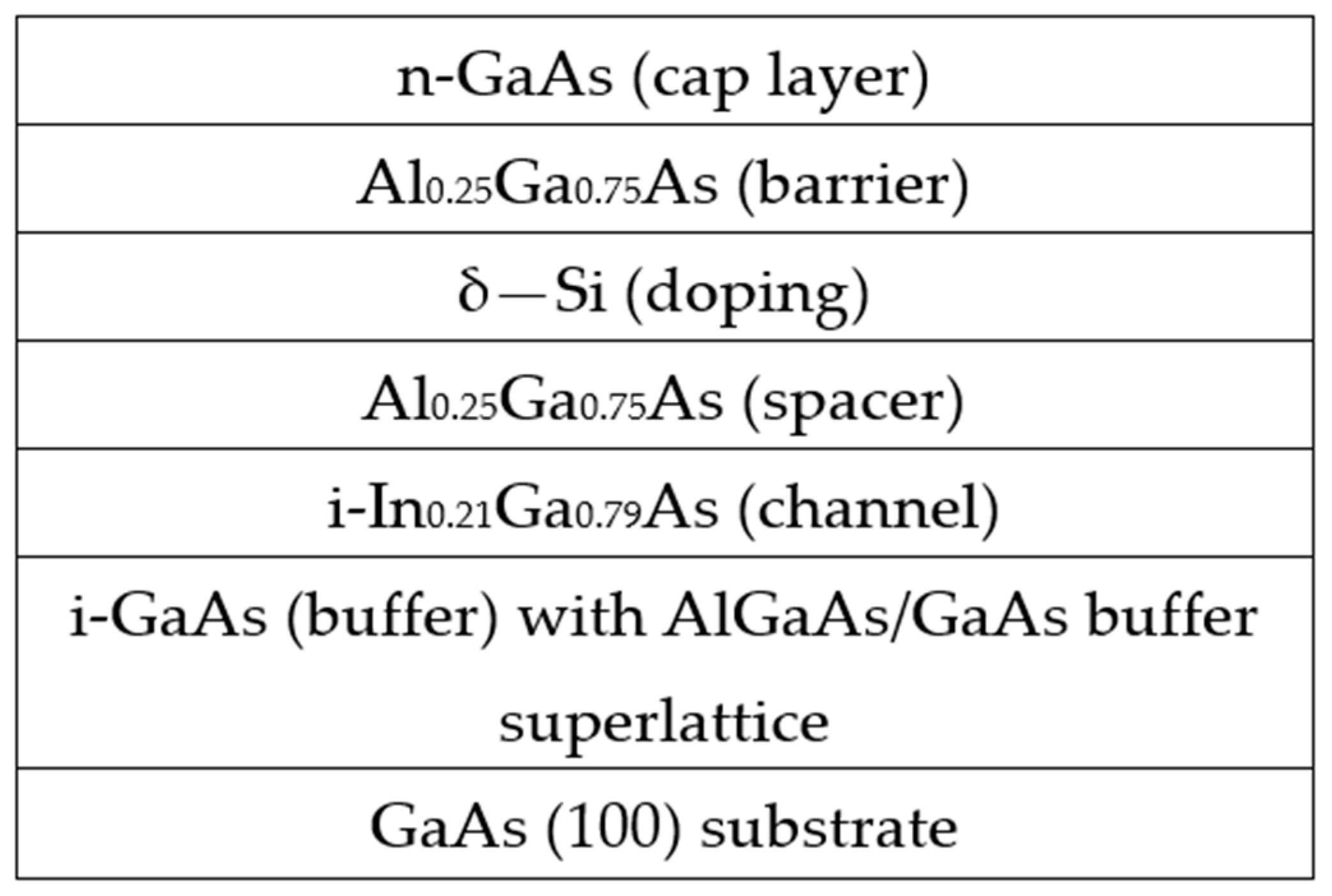

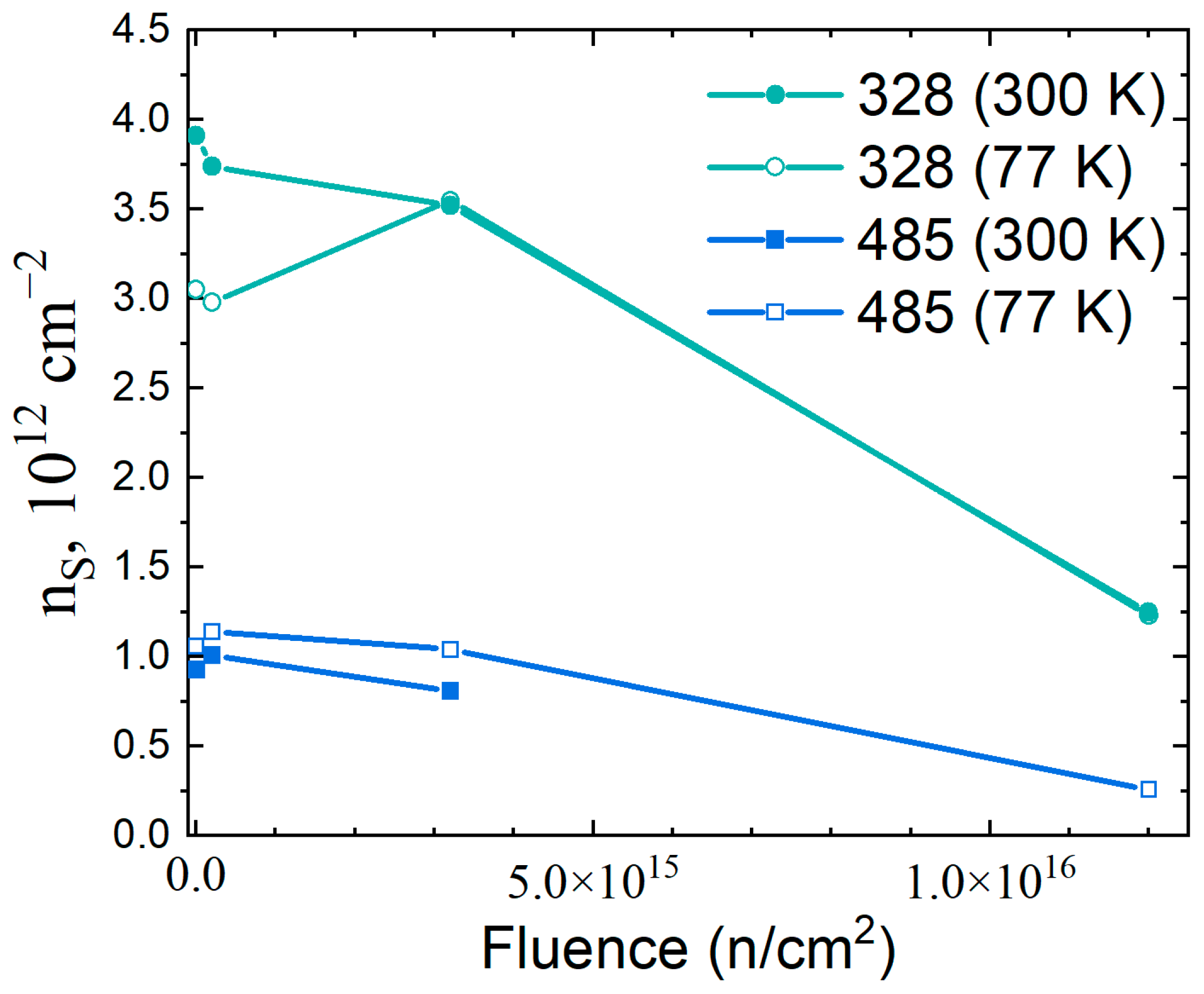
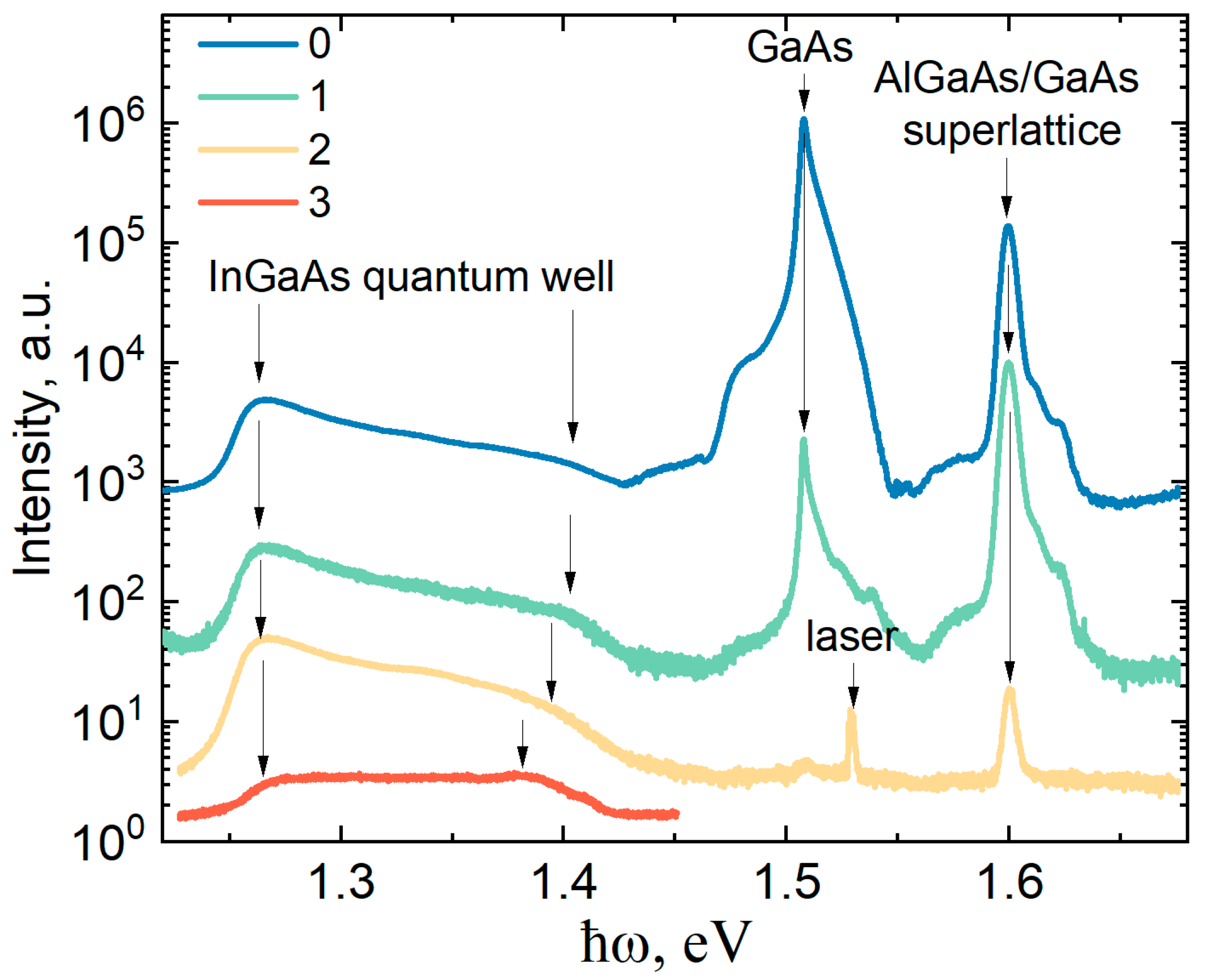

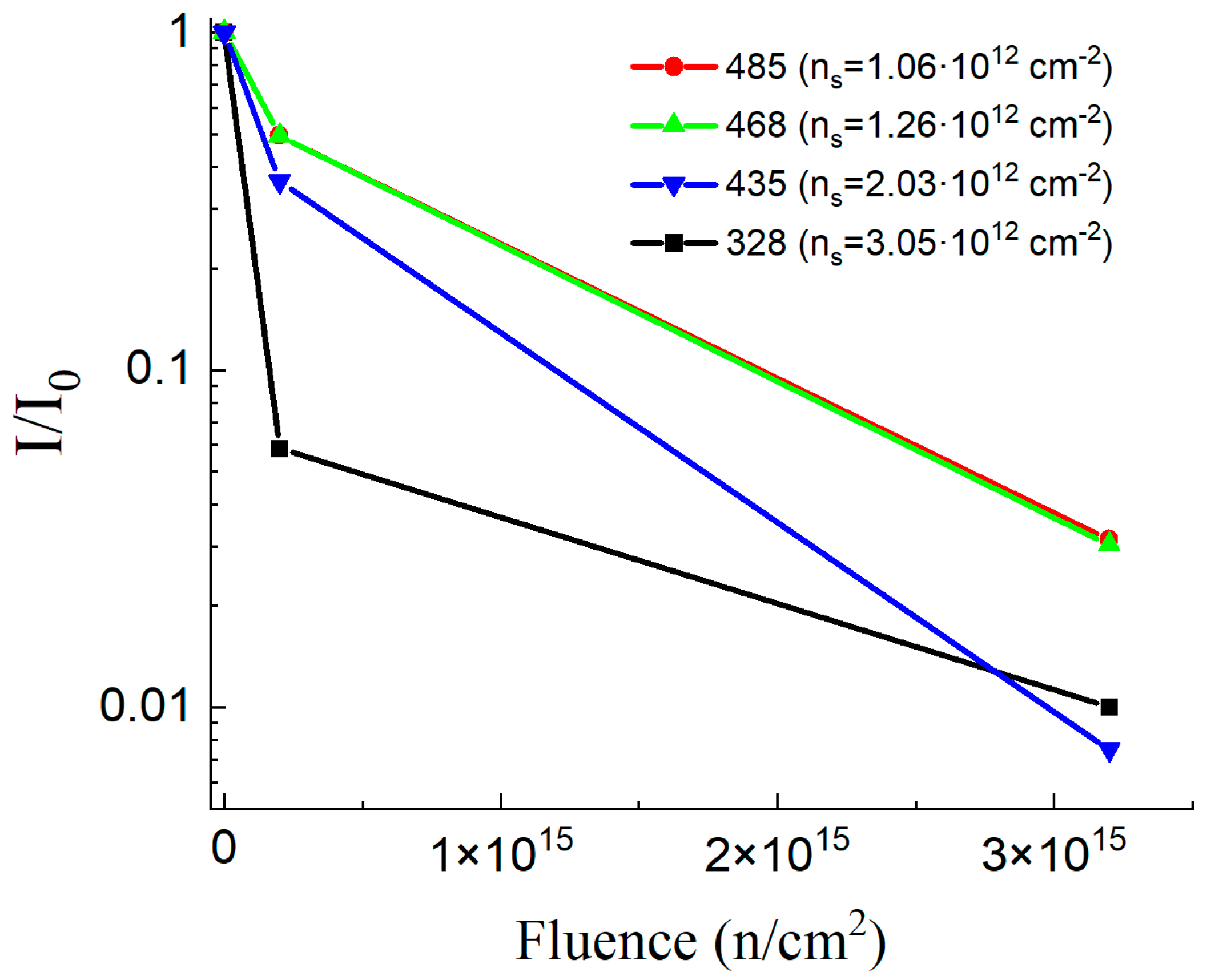
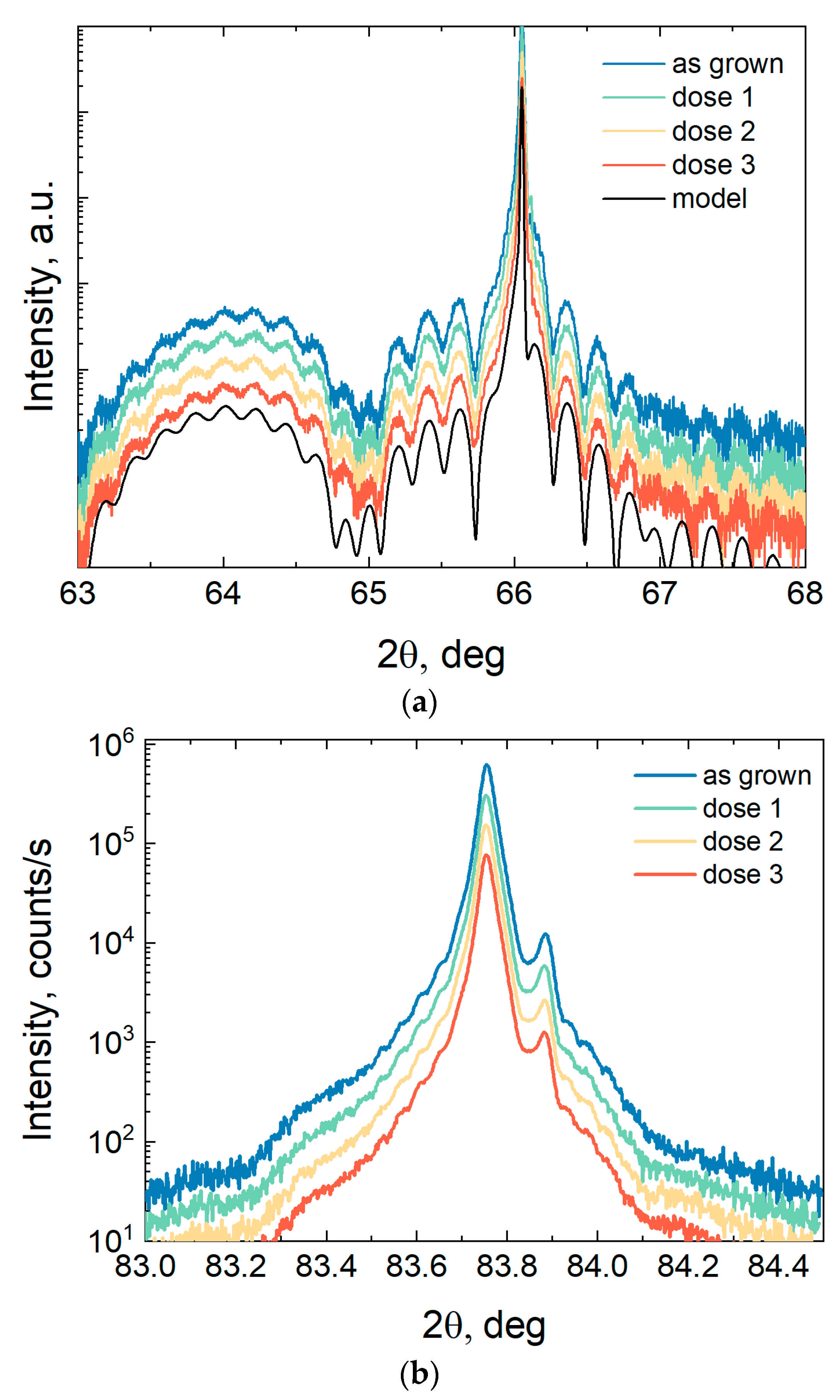
| Sample | Neutron Fluence, cm−2 | T = 77 K | T = 300 K | |||
|---|---|---|---|---|---|---|
| ns, 1012 cm−2 | µ, cm2/V·s | ns, 1012 cm−2 | µ, cm2/V·s | |||
| #485 | 0 | - | 1.06 | 26,220 | 0.93 | 7210 |
| 1 | 2 × 1014 | 1.14 | 26,400 | 1.01 | 7190 | |
| 2 | 3.2 × 1015 | 1.04 | 12,780 | 0.81 | 4880 | |
| 3 | 1.2 × 1016 | 0.26 * | 250 * | - | - | |
| #328 | 0 | - | 3.05 | 33,180 | 3.91 | 7080 |
| 1 | 2 × 1014 | 2.98 | 23,420 | 3.74 | 6810 | |
| 2 | 3.2 × 1015 | 3.55 | 12,950 | 3.48 | 5720 | |
| 3 | 1.2 × 1016 | 1.23 | 1190 | 1.25 | 1070 | |
| Sample | n, 1012 cm−2 | μ, cm2/V·S | n, 1012 cm−2 | μ, cm2/V·s |
|---|---|---|---|---|
| 300 K | 77 K | |||
| 435 | 2.03 | 7500 | 1.88 | 29,300 |
| 468 | 1.26 | 7100 | 1.26 | 22,000 |
| 485 | 0.93 | 7210 | 1.06 | 26,220 |
Disclaimer/Publisher’s Note: The statements, opinions and data contained in all publications are solely those of the individual author(s) and contributor(s) and not of MDPI and/or the editor(s). MDPI and/or the editor(s) disclaim responsibility for any injury to people or property resulting from any ideas, methods, instructions or products referred to in the content. |
© 2023 by the authors. Licensee MDPI, Basel, Switzerland. This article is an open access article distributed under the terms and conditions of the Creative Commons Attribution (CC BY) license (https://creativecommons.org/licenses/by/4.0/).
Share and Cite
Klochkov, A.N.; Yskakov, A.; Vinichenko, A.N.; Safonov, D.A.; Kargin, N.I.; Bulavin, M.V.; Galushko, A.V.; Yamurzin, V.R.; Vasil’evskii, I.S. Effect of Neutron Irradiation on the Electronic and Optical Properties of AlGaAs/InGaAs-Based Quantum Well Structures. Materials 2023, 16, 6750. https://doi.org/10.3390/ma16206750
Klochkov AN, Yskakov A, Vinichenko AN, Safonov DA, Kargin NI, Bulavin MV, Galushko AV, Yamurzin VR, Vasil’evskii IS. Effect of Neutron Irradiation on the Electronic and Optical Properties of AlGaAs/InGaAs-Based Quantum Well Structures. Materials. 2023; 16(20):6750. https://doi.org/10.3390/ma16206750
Chicago/Turabian StyleKlochkov, Aleksey N., Almas Yskakov, Aleksander N. Vinichenko, Danil A. Safonov, Nikolay I. Kargin, Maksim V. Bulavin, Aleksey V. Galushko, Vladik R. Yamurzin, and Ivan S. Vasil’evskii. 2023. "Effect of Neutron Irradiation on the Electronic and Optical Properties of AlGaAs/InGaAs-Based Quantum Well Structures" Materials 16, no. 20: 6750. https://doi.org/10.3390/ma16206750
APA StyleKlochkov, A. N., Yskakov, A., Vinichenko, A. N., Safonov, D. A., Kargin, N. I., Bulavin, M. V., Galushko, A. V., Yamurzin, V. R., & Vasil’evskii, I. S. (2023). Effect of Neutron Irradiation on the Electronic and Optical Properties of AlGaAs/InGaAs-Based Quantum Well Structures. Materials, 16(20), 6750. https://doi.org/10.3390/ma16206750






